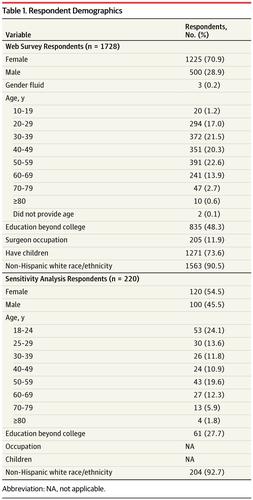JAMA Surgery ( IF 15.7 ) Pub Date : 2018-05-01 , DOI: 10.1001/jamasurg.2017.5310 Alexis L. Hanson 1 , Ross D. Crosby 2, 3 , Marc D. Basson 1

|
Importance Studies have compared surgical with nonsurgical therapy for acute uncomplicated appendicitis, but none of these studies have a patient-centered perspective.
Objectives To evaluate how patients might choose between surgical and nonsurgical therapy for acute uncomplicated appendicitis and to identify targets to make antibiotic treatment more appealing.
Design, Setting, and Participants This study comprised an online survey and an in-person sensitivity analysis survey. For the web survey, a convenience sample of 1728 respondents were asked to imagine that they or their child had acute uncomplicated appendicitis, provided information about laparoscopic and open appendectomy and antibiotic treatment alone, and asked which treatment they might choose. The web survey was open from April 17, 2016, through June 16, 2016, and was disseminated via email link, a poster with a Quick Response code, and social media. For the sensitivity analysis, 220 respondents were given the same scenario and options. Those who chose surgery were asked whether certain factors influenced their decision; each factor was incrementally improved during questioning about whether respondents would consider switching to antibiotics. These participants were recruited at public venues from June 3, 2016, to July 31, 2016. Web survey data were analyzed from June 17, 2016, to September 21, 2017. Sensitivity analysis data were analyzed from August 1, 2016, to September 21, 2017.
Main Outcomes and Measures Treatment preferences.
Results Among the 1728 web survey respondents, 1225 (70.9%) were female and 500 (28.9%) were male (3 [0.2%] either did not answer or responded as “gender fluid” within the comments section of the survey), and most self-reported being between 50 and 59 years of age (391 [22.6%]) and being non-Hispanic white (1563 [90.5%]). For themselves, 1482 respondents (85.8%) chose laparoscopic appendectomy, 84 (4.9%) chose open appendectomy, and 162 (9.4%) chose antibiotics alone. For their child, 1372 respondents (79.4%) chose laparoscopic appendectomy, 106 (6.1%) open appendectomy, and 250 (14.5%) antibiotics alone. Respondents were somewhat more likely to choose antibiotics for themselves if they had education beyond college (105 [12.6%]; P < .001), identified as other than non-Hispanic white (24 [14.9%]; P < .001), or did not know anyone who had previously been hospitalized (12 [15.8%]; P = .02), but they were less likely to choose antibiotics if they were surgeons (11 [5.4%]; P = .008). Of the 220 participants interviewed for the sensitivity analysis, 120 (54.5%) were female and 100 (45.5%) were male, and most self-reported being between 18 and 24 years of age (53 [24.1%]) and being non-Hispanic white (204 [92.7%]). Their responses suggested that improvements in the short- and long-term failure rate of antibiotic treatment—rather than reductions in the duration of hospitalization or antibiotic treatment—were more likely to increase the desirability of choosing antibiotics.
Conclusions and Relevance Most patients may choose surgical intervention over antibiotics alone in treatment of acute uncomplicated appendicitis, but a meaningful number may choose nonoperative management. Therefore, from a patient-centered perspective, this option should be discussed with patients, and future research could be directed at reducing the failure and recurrence rates of antibiotic treatment for appendicitis.
中文翻译:

手术或使用抗生素治疗急性阑尾炎的患者偏爱
重要性 研究比较了急性非并发症性阑尾炎的手术治疗与非手术治疗,但这些研究都没有以患者为中心的观点。
目的 评估患者在急性单纯性阑尾炎中如何在手术和非手术治疗之间进行选择,并确定目标,使抗生素治疗更具吸引力。
设计,设置和参与者 这项研究包括在线调查和面对面的敏感性分析调查。在网上调查中,对1728名受访者的便利样本进行了调查,以想象他们或他们的孩子患有急性单纯性阑尾炎,仅提供有关腹腔镜和开放式阑尾切除术以及抗生素治疗的信息,并询问他们可能选择哪种治疗方法。该网络调查于2016年4月17日至2016年6月16日开放,并通过电子邮件链接,带有快速响应代码的海报和社交媒体进行了传播。在敏感性分析中,为220位受访者提供了相同的方案和选项。那些选择手术的人被问到某些因素是否影响他们的决定。在询问受访者是否会考虑改用抗生素的过程中,每个因素都得到了逐步改善。
主要结果和衡量指标 治疗偏好。
结果 在1728位网络调查的受访者中,女性占1225位(占70.9%),男性占500位(占28.9%)(3位[0.2%]在调查的评论部分未回答或回答为“性别不平等”),并且大部分自我报告的年龄介于50至59岁之间(391 [22.6%]),而非西班牙裔白人(1563 [90.5%])。就他们自己而言,有1482位受访者(85.8%)选择了腹腔镜阑尾切除术,有84位(4.9%)选择了开放性阑尾切除术,有162位(9.4%)选择了单独的抗生素。对于他们的孩子,有1372名受访者(79.4%)仅选择了腹腔镜阑尾切除术,106例(6.1%)开放性阑尾切除术和250例(14.5%)抗生素。如果受访者受过大学以上的教育(105 [12.6%];P <.001),被确定为非西班牙裔白人(24 [14.9%];非西班牙裔白人除外),则他们更有可能自行选择抗生素。P <.001),或者不认识任何曾经住院的人(12 [15.8%];P = .02),但是如果他们是外科医师,他们选择抗生素的可能性较小(11 [5.4%];P = .008)。在接受敏感性分析的220名受访者中,女性为120名(54.5%),男性为100名(45.5%),并且大多数自我报告的年龄在18至24岁之间(53 [24.1%]),并且没有西班牙裔白人(204 [92.7%])。他们的回答表明,抗生素治疗短期和长期失败率的改善,而不是住院或抗生素治疗时间的减少,更有可能增加选择抗生素的意愿。
结论和相关性 大多数患者在急性并发性阑尾炎的治疗中可能会选择手术干预而非单纯使用抗生素,但相当数量的患者可能会选择非手术治疗。因此,从以患者为中心的角度出发,应与患者讨论该选择方案,未来的研究应针对减少阑尾炎抗生素治疗的失败率和复发率。











































 京公网安备 11010802027423号
京公网安备 11010802027423号